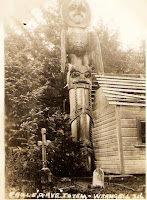Walk Among Totems
“Our Canoe is not floating in one place. We are going through life & the landscape around us is always changing.”-- Kenneth Grant, T’akdeintaan

 I walk among totems. One of my favorite places to walk is Sitka's Totem Park, which is officially called Sitka National Historic Park. When
I walk through the park I remind my children and grandchildren that they’ve
been here more than ten thousand years. Their names and stories are breathed into the totem poles.
I walk among totems. One of my favorite places to walk is Sitka's Totem Park, which is officially called Sitka National Historic Park. When
I walk through the park I remind my children and grandchildren that they’ve
been here more than ten thousand years. Their names and stories are breathed into the totem poles.
The
totem poles weren’t erected until 1906 when Alaska’s District Governor John G.
Brady brought the poles to Sitka after they were displayed in the St. Louis
World’s Fair. Since then the poles have been replicated and in more recent
years by master carvers such as Tommy Joseph
Over the
years I’ve heard ignorant statements like “totem poles are evil” and “the
Tlingit worshiped totem poles." Of course, both statements are untrue. Most
totem poles serve the following functions:
* Crest poles give the ancestry of
particular family.
*
History poles record the history of a clan.
* Legend poles illustrate folklore or real life experiences.
* Memorial poles commemorate a particular
individual.
Most
importantly, as we walk through the park we remember the Battle of Sitka in
1804 when Shis'kí Noow,
the Tlingit fort (250 feet by 165 feet), was attacked by the Russian colonizers.
Two years prior, in 1802, the Tlingit attacked a Russian fort driving the invaders out of the area. This time, though, the Russians had
cannons and a huge ship plus they’d enslaved other indigenous peoples to assist
in attacking the Tlingit fort. Many lives on both sides were lost. Eventually
the Tlingits took their elders, women, and children on a survival march,
leading them to a safe place some distance from the area.



Comments